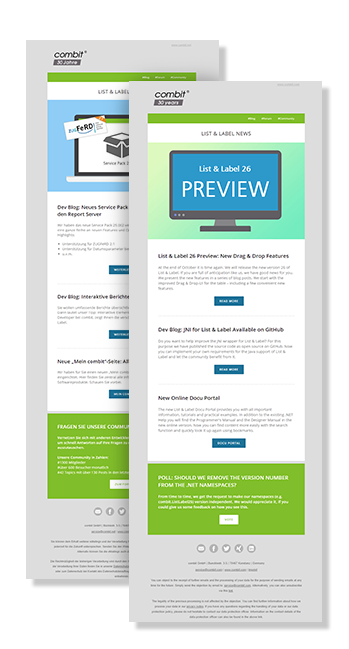Now there is the possibility to add your custom Designer objects and functions to List & Label on the server and use them in the Web Designer or Report Server Designer on a client afterwards.
Web Designer
To add your DesignerObjects and DesignerFunctions instances to the Web Designer, you need to add information about the extension assemblies and their classes to the web application’s configuration on the server. The WebDesignerOptions class has a new property ExtensionAssemblies to do so. A simple snippet would look like this. The sample assumes a folder called “extensions” in the root folder of the web application that contains the assemblies to load.
string dllPath = Path.Combine(AppDomain.CurrentDomain.BaseDirectory, "extensions");
options.ExtensionAssemblies.Add(new combit.ListLabel24.Web.WebDesigner.WebDesignerExtension()
{
AssemblyName = "[YourExtensionAssemblyName].dll",
ExtensionDirectory = dllPath,
Dependencies = new List<string> { "[YourFirstExtensionAssemblyDependencyName].dll", "[YourSecondExtensionAssemblyDependencyName].dll", [...] },
ExtensionClasses = new System.Collections.Generic.List<combit.ListLabel24.Web.WebDesigner.WebDesignerExtensionClass>(){
new combit.ListLabel24.Web.WebDesigner.WebDesignerExtensionClass(){
ClassName = "YourExtensionClassName", // this class should be derived from the DesignerObject class
ExtensionType = combit.ListLabel24.Web.WebDesigner.WebDesignerExtensionType.DesignerObject
}
}
});
Report Server Designer
To add your DesignerObjects and DesignerFunctions instances to the Report Server Designer, you need to add information about the extension assemblies and their classes to the privateSettings.config file in the WebUI folder of the Report Server application on the server. A simple snippet would look like this. The sample assumes a folder called “C:Temp” that contains the assemblies to load. The IIS Application Pool user needs to have read access to this folder.
<setting key="DesignerExtensions"> <DesignerExtensions> <DesignerExtension Name="[YourExtensionAssemblyName].dll" Path="C:Temp"> <Dependency Name="[YourFirstExtensionAssemblyDependencyName].dll" /> <Dependency Name="[YourSecondExtensionAssemblyDependencyName].dll" /> [...] <ExtensionClass ClassName="[YourExtensionClassName]" ExtensionType="DesignerObject"></ExtensionClass> </DesignerExtension> </DesignerExtensions> </setting>
Loading the Extensions
By adding this code to the web application’s configuration or the Report Server privateSettings.config file on the server, the Web Designer respectively the Report Server Designer on the client will automatically try to download the assembly and load it as a new extension. Anytime that a new version of the assembly is available on the server in the same folder, by restarting any client it will find out about the change and download the new assembly automatically again. If the assembly remains unchanged on the server and has been downloaded before, almost no network traffic will be used up as just the checksum of the file is transferred






This only seems to work with MVC. How does this work with an Asp.Net Forms application? The combit.ListLabel25.Web.DesignerControl does not seem to support ExtensionAssemblies
Unfortunately – yes, this is only supported for MVC currently. I’m sorry.